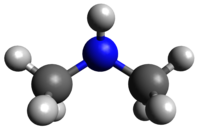Dimethylamine
 | |
|---|---|
| Species tag | 045532 |
| Version | 1* |
| Date of Entry | Jun 2023 |
| Contributor | H. S. P. Müller |
|
Dimethylamine (DMA) possesses two equivalent minima. Rotation leads
to two tunneling substates 0+ and 0–,
the latter being 1323 MHz higher in energy. The rotational
transitions obey b-type selection rules, whereas the
stronger rotation-tunneling transitions obey c-type
selection rules. | |
| Lines Listed | 22999 |
| Frequency / GHz | < 2000 |
| Max. J | 65 |
| log STR0 | -7.5 |
| log STR1 | -6.5 |
| Isotope Corr. | |
| Egy / (cm–1) | 0.0 / 0.0441 |
| µa / D | |
| µb / D | 0.295 |
| µc / D | 0.967 |
| A / MHz | 34242.442 |
| B / MHz | 9334.296 |
| C / MHz | 8215.651 |
| Q(300.0) | 822487.8817 |
| Q(250.0) | 625513.5474 |
| Q(225.0) | 534004.2559 |
| Q(200.0) | 447470.9752 |
| Q(180.0) | 382025.6185 |
| Q(170.0) | 350623.5753 |
| Q(160.0) | 320135.2065 |
| Q(150.0) | 290588.3240 |
| Q(140.0) | 262013.4910 |
| Q(125.0) | 221048.8001 |
| Q(100.0) | 158173.3256 |
| Q(75.00) | 102752.3393 |
| Q(50.00) | 55958.0584 |
| Q(37.50) | 36366.3518 |
| Q(18.75) | 12889.3154 |
| Q(9.375) | 4580.6180 |
| Q(5.000) | 1800.4981 |
| Q(2.725) | 736.4721 |
| detected in ISM/CSM | no |